
views
Sorting Your Clothes and Getting Ready

Find a laundromat in your area to make carrying your clothes easier. If you don’t know where your closest laundromat is located, look online to find a laundromat that won’t require a lot of travel. Hauling your clothes all over the place is a pain, so go to the laundromat closest to you unless you have unique requirements or a vehicle that you can drive to the laundromat. If you’re carrying a lot of laundry, don’t risk your back by walking to the laundromat if it’s farther than 1 block away. Laundromats tend to be busier on the weekend. If you want the best chance of getting an open machine, do your laundry during the week. Some laundromats are open 24 hours a day. Look for a laundromat that is always open if you want to do your laundry late at night or early in the morning.
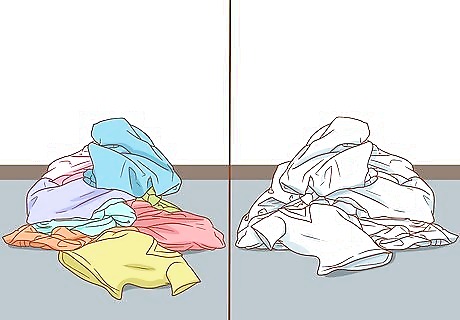
Separate your colors and whites and layer them in your laundry basket. Some people will wash whites on one night and return to the laundromat the next day to wash their colors. Many people simply use 2 machines to wash their colors and whites at the same time. Either way, sort your laundry into 2 separate piles based on the color. Put your whites at the bottom of the laundry basket and place your colors on top. Alternatively, you can get 2 laundry bags to keep your clothes sorted as you travel. This way, you won’t need to waste time separating your clothes at the laundromat. You can put a sheet of cardboard or some other kind of divider in between your colors and whites if you want to make retrieving each set of clothes from a single basket easier. If you’re walking to the laundromat, a cloth laundry bag will be easier to carry than a hard-plastic or metal bin. If you’re really dedicated to washing materials properly, read each tag on your items of clothing for washing instructions and sort lighter colors from your darks. Wash your jeans separately, and keep delicate fabrics together for a separate load.
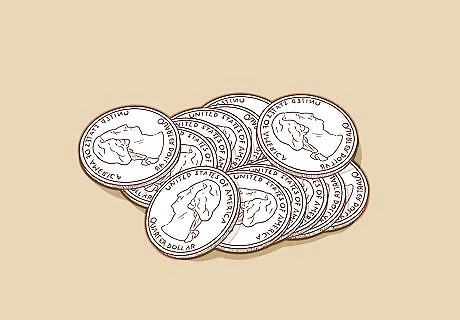
Bring change with you to operate the washing machines and dryers. The machines at laundromats are almost always coin-operated. Loads typically cost $0.50-2.00 depending on where you live and the size of the machine that you’re using. Take a bag full of change with you to the laundromat to operate the machines. Tip: The average load of laundry is 6–7 pounds (2.7–3.2 kg). Estimate the weight of your laundry to determine how many coins you’re going to need. Bring extra change in case you underestimate how many loads of laundry you have to do. Newer laundromats may have machines that take credit and debit cards, but these machines are pretty rare. Don’t assume that you’ll be able to use a card without contacting the laundromat first.

Bring your laundry detergent, dryer sheets, and fabric softener with you. Laundromats typically sell detergent, dryer sheets, and fabric softener, but the prices are much higher than they normally are at a grocery or corner store. To save money, bring laundry detergent and any fabric softener with you to avoid needing to buy them at the store.
Using a Laundromat’s Washing Machines

Find a washing machine that is unoccupied and check inside the drum. Once you walk into the laundromat, look for a washing machine that isn’t in use. When you find one, put your laundry basket down and open the door. Look inside to ensure that the last person to use the machine hasn’t left anything behind. Smell the drum before using it. If it smells like bleach, avoid putting non-white clothing inside. Some laundromats offer several sizes of machine. If your laundromat does, feel free to grab a bigger machine if you think it’ll save you some time. Larger machines are typically designed to hold twice as many clothes as a standard machine. Try to avoid grabbing a machine next to an in-use machine in case the other person is planning on using multiple machines. If there is something in the machine and there’s a clerk at the laundromat, turn the lost item into the clerk. If there isn’t an employee there, leave the forgotten item on top of the machine.
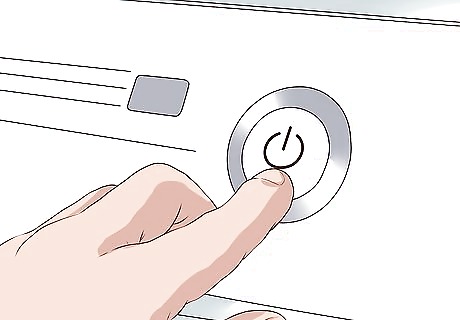
Use 2 washing machines if you’re washing colors and whites separately. If you have 2 loads of laundry to do, look for 2 empty machines that are right next to one another. If the laundromat is completely packed though, it is considered bad etiquette to take up 2 machines. Avoid loading the machines past the rim of the drum. If you do, your clothes won’t get properly cleaned and you may damage the machine. It is not ideal to use 2 machines that are located in different parts of the store. If someone tries messing with your laundry, you want to be there.
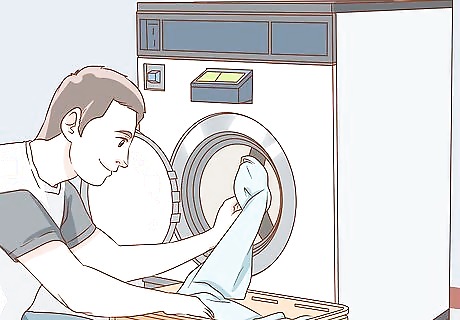
Load your clothes and add your detergent. Once you’ve selected a machine, load your clothes into the drum. If you’re using multiple machines, load both machines at the same time. Add detergent based on how big your load of laundry is. The average load of laundry is 6–7 pounds (2.7–3.2 kg) and will fill 3/4 of a standard machine. Fill the cap halfway with detergent for an average load and adjust accordingly if you have more or less laundry to do. There are usually instructions on the container of laundry detergent that suggest how much soap you should use. There are also hash marks on the inside of the cap indicating what a full or half load is for your particular detergent. If you’re using pods, put 1 pod in with each load, regardless of how many clothes you’re washing. Many people prefer to use less soap. If you want to cut back on soap, fill your cap so that it’s 1/8 full. This is usually 2 tablespoons (30 mL) for a standard detergent. Follow the manufacturer’s instructions for adding fabric softener. Typically, you fill the cap either halfway or to the rim and add it directly to your laundry.
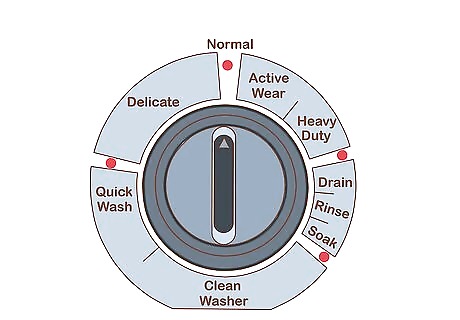
Insert your coins and turn the dial to your preferred setting. Once your clothes are loaded, insert coins into the slot on the machine. Turn the dial to the cycle that you want to run and press the “Start” button or pull the dial out to initiate the cycle. For a standard cycle, use the “Standard,” “Normal,” or “Cotton” setting. If you’re washing sensitive fabrics or expensive items, use the “Delicates” setting. “Permanent Press” is designed to wash jeans or clothes that wrinkle easily. Some machines have separate cycles for whites and colors. Use these settings if they’re available and you’ve sorted your laundry by color.

Wait for the cycle to finish. Bring a book, handheld game, or newspaper if you want to distract yourself while the clothes are drying. Alternatively, use your time to get some work done, answer emails, or finish homework. Stay in the laundromat if you want to assure that nobody messes with your clothes and your cycle runs through to completion. Variation: If there’s a clerk at the laundromat and you’re not worried about anyone messing with your clothes, feel free to leave while the cycle is running. People in major cities often leave their clothes unattended when they’re washing or drying, although there is always a risk involved. If you do leave, return before the cycle finishes though to avoid having someone take your clothes out to use the machine while it isn’t running.
Drying Your Clothes at the Laundromat
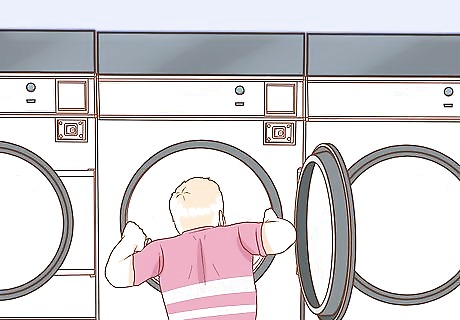
Find an unoccupied dryer nearby and inspect it. Often, there’s a dryer attached to each laundry machine at the laundromat. If there isn’t, you’ll need to move your clothes, though. Either way, once you find an unoccupied dryer, open it to inspect the drum and look for forgotten items of clothing. Take a sniff to see if the drum smells moldy or wet. If it does, the machine is likely not working properly. Find a different dryer if this is the case. Like the washing machines, you can use multiple drying machines at the same time if you’re drying multiple loads.
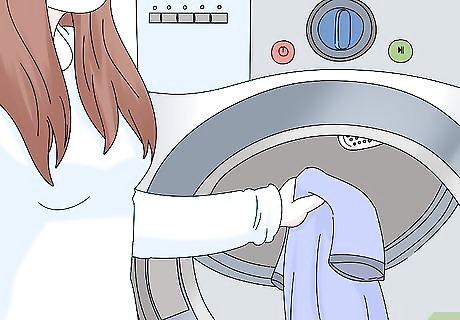
Load your clothes into the dryer. Dry each individual load of clothing in separate dryers. Remove your wet clothes and transfer them to your dryer. When you finish loading the clothes, put your coins into the corresponding slot to turn the machine on.
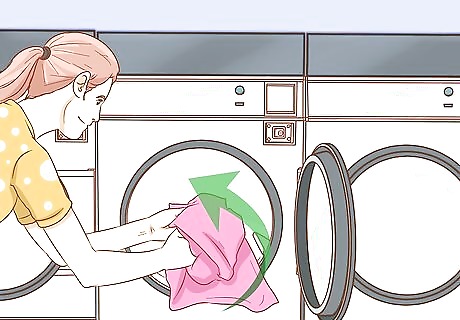
Insert coins and select your dryer setting before starting the cycle. Use the standard cycle for a standard wash load. Use the “Delicate” or “Low Heat” setting for sensitive fabrics. If there’s a timed cycle, use 45-60 minutes based on the size of your load. Pull the dial out or press the “Start” button to initiate your cycle. Some machines allow you to adjust the amount of heat that you use to dry your clothes. The more heat that you use, the more likely your clothes are to shrink—especially if they’re made out of cotton. If you aren’t sure if you can machine dry a particular item of clothing, read the tag. There are washing and drying instructions on most clothing tags. Feel free to add dryer sheets or dryer balls to your dryer if you want to keep your clothes wrinkle and static free.
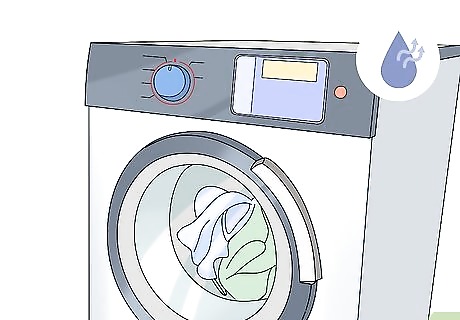
Wait for the drying cycle to finish. Once your drying cycle starts, you’ll have another 30-60 minutes to kill. Continue reading your book, answering emails, or catching up on homework. Stay nearby to ensure that nobody interrupts your cycle. If you felt comfortable leaving during the wash cycle, there’s no reason you can’t leave again. Feel free to go grab a cup of coffee or hang out at a nearby store.

Remove your clothes and fold them if you’d like. When the dryer finishes running, open the door and remove your clothes. You can fold them if you’d like, but there’s no rule that you have to do it at the laundromat. It’s totally up to you whether you want to fold your clothes before putting them back in your laundry basket and going home. Tip: Folding your clothes as soon as they come out of the dryer reduces the odds that static cling and wrinkles develop on your clothes. Fold them at the laundromat if wrinkle- and static-free clothing is important to you.

















Comments
0 comment